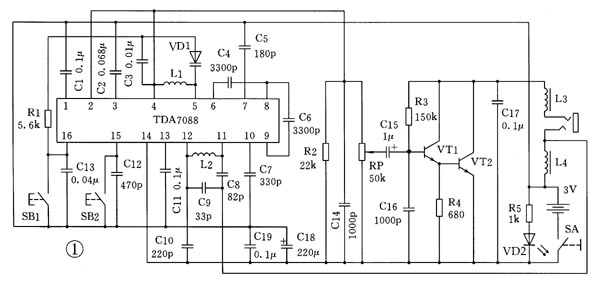The main difference between auto-searching FM radios and ordinary FM radios is their different tuning methods. The automatic search FM radio adopts the electric tuning method to select the radio station, eliminating the need for a variable capacitor, and setting two touch buttons of "search" and "reset". As long as you press the search button during use, the radio will automatically search for a radio station. When it finds a radio station, it will tune in accurately and stop. If you want to change a radio station, just press the search button again, and the radio will continue to search for radio stations towards the higher end of the frequency. When you tune to the highest frequency, you need to press the reset button to return the radio local oscillation frequency to the lowest end before you can start searching for the station again. This automatic search FM radio is easy to use and accurate to tune. Because it does not use variable capacitors, it has a long service life (variable capacitors are easy to damage). Its disadvantage is that there is no frequency indication.
First, the working principle of the circuit Figure 1 is an electrical schematic diagram of automatic search for FM radio. The core device is a TDA7088 integrated circuit, which contains 
In the radio frequency receiver from the antenna, oscillator, mixer, AFC (frequency automatic control) circuit, IF amplifier (IF frequency is 70kHz), IF limiter, IF filter, discriminator, low frequency squelch circuit, audio All functions such as output are also equipped with search tuning circuit, signal detection circuit and frequency locked loop.
The variable capacitor is replaced by a varactor diode, which is a special kind of diode. Its PN junction capacitance changes as the bias voltage (reverse voltage) on the PN junction changes. As the bias voltage increases, the PN junction becomes thicker and the capacitance of the PN junction becomes smaller; when the bias voltage decreases, the PN junction becomes thinner, the PN junction capacitance increases. Therefore, by changing the bias voltage on the PN junction, the capacitance of the PN junction can be changed. The varactor diode in the circuit is connected to the local oscillation circuit to change the oscillation frequency.
Because it is difficult to integrate a larger-capacity capacitor in an integrated circuit, there are many capacitors externally connected to the integrated circuit. Capacitor C1 connected to pin 1 of the TDA7088 integrated circuit is a noise suppression capacitor; pin 3 is connected to a loop filter component; C4 on pin 6 is an intermediate frequency feedback capacitor; C5 on pin 7 is a low-pass capacitor; pin 8 is an intermediate frequency output; Pin 9 is the intermediate frequency input; C7 on the {10} pin is the low-pass capacitor of the IF limiting amplifier; Pin {15} is the search tuning input, and C12 is the filter capacitor; {16} is the electric tuning and AFC output .
The headphone cable of the FM radio doubles as an antenna, the radio signal is sent to the pins {11} and {12} of the integrated circuit, and the inductance L2, capacitors C8, C9, and C10 form the input loop. The frequency of the circuit is determined by L1, C3 and varactor diode VD1. The 70kHz intermediate frequency signal generated after mixing becomes an audio signal after passing through the intermediate frequency amplifier, intermediate frequency limiter, intermediate frequency filter, and frequency discriminator in the integrated circuit, which is output by the second pin of the integrated circuit and sent to the volume potentiometer. The capacitor C15 is then sent to a low-frequency amplifier circuit composed of transistors VT1, VT2, etc. for amplification, and the headphones are driven to sound. The inductors L3 and L4 connected to the headphone jack are provided to prevent the antenna signal from being bypassed by the headphone. The light-emitting diode and resistor R6 form a power supply display circuit. Capacitors C18 and C19 are power supply filter circuits. Capacitor C17 is used to improve sound quality.
Second, the production of the circuit Figure 2 is a schematic diagram of the component installation of the automatic search FM radio.
First, the 16-pin dual-row mini flat package integrated circuit TDA7088 is soldered on the copper-plated surface of the circuit board. Because the IC pin clearance is very small, you must be very careful when soldering. The pins of the integrated circuit and the soldering points on the circuit board can be tinned first, after the solder on the soldering iron head is thrown away, the integrated circuit is aligned to the soldering point on the circuit board (1 pin of the integrated circuit is in the headphone socket Side), solder with an electric soldering iron without solder. Secondly, solder 4 jumpers, 5 resistors and 2 inductors to the circuit board. Solder 17 capacitors, 2 electrolytic capacitors, 2 transistors, varactor diodes, 2 coils, potentiometers, earphone sockets, tact switches, and light-emitting diodes to the circuit board in turn. Note that the height of the light emitting diode should be matched with the chassis. Finally, connect the positive and negative poles of the battery contacts with wires.
After all the components are installed and checked, they can be debugged. The power consumption when the circuit is not connected to the headphones is about 7mA, and the total power consumption when listening at the maximum volume is about 15mA. Adjust the density of the coil L1 to adjust the frequency range of the radio reception. If the radio at the high frequency end cannot be received, the coil can be opened a little; if the radio at the low frequency end cannot be received, the coil can be clamped a little. Since the automatic search FM radio has no frequency indication, you can find a common FM radio for frequency comparison.
3. Assembly First put the battery contact piece into the case. Then put the two buttons into the shell, making the two buttons one lower and one higher, corresponding to the search button and reset button respectively. Then put the circuit board into the shell and fix it with screws. Finally install the knob of the potentiometer.
In-depth analysis of the first-level cache and second-level cache of the technical zone CPU eMMC mass burning dilemma, do you really know? Isolation flyback and non-isolated BUCK application design plan Schottky barrier diode selection and application guide How to use Altium in program design Designer puzzle?  Follow WeChat Interesting and informative information and technical dry goods  Download Audiophile APP Create your own personal electronic circle  Follow the audiophile class Lock the latest course activities and technical live broadcast Collect People collection share it: related suggestion Simple secondary frequency conversion FM radio The following introduces a highly sensitive FM radio suitable for weak signal areas and remote mountain areas, ... Published on 2006-04-16 19:49 • 1831 times read  [Photo] Circuit diagram of automatic hand washer 2 Posted at 2006-04-16 17:23 • 229 times read ![[Photo] Circuit diagram of automatic hand washer 2](http://i.bosscdn.com/blog/20/06/41/6172330698.gif) [Photo] Circuit diagram of automatic hand washer Posted at 2006-04-16 17:20 • 200 views ![[Photo] Circuit diagram of automatic hand washer](http://i.bosscdn.com/blog/20/06/41/6172044809.gif) ![]() '+ data.username +' '+ data.username +' |